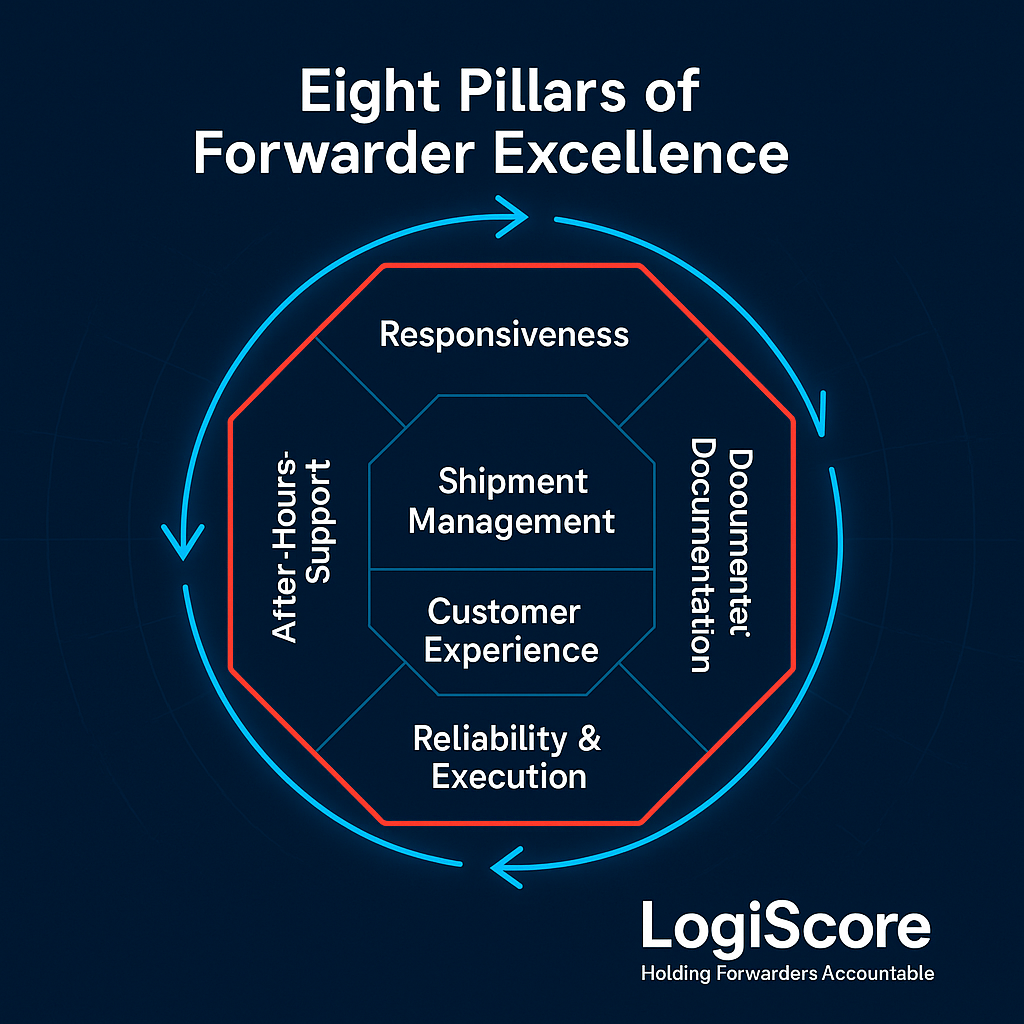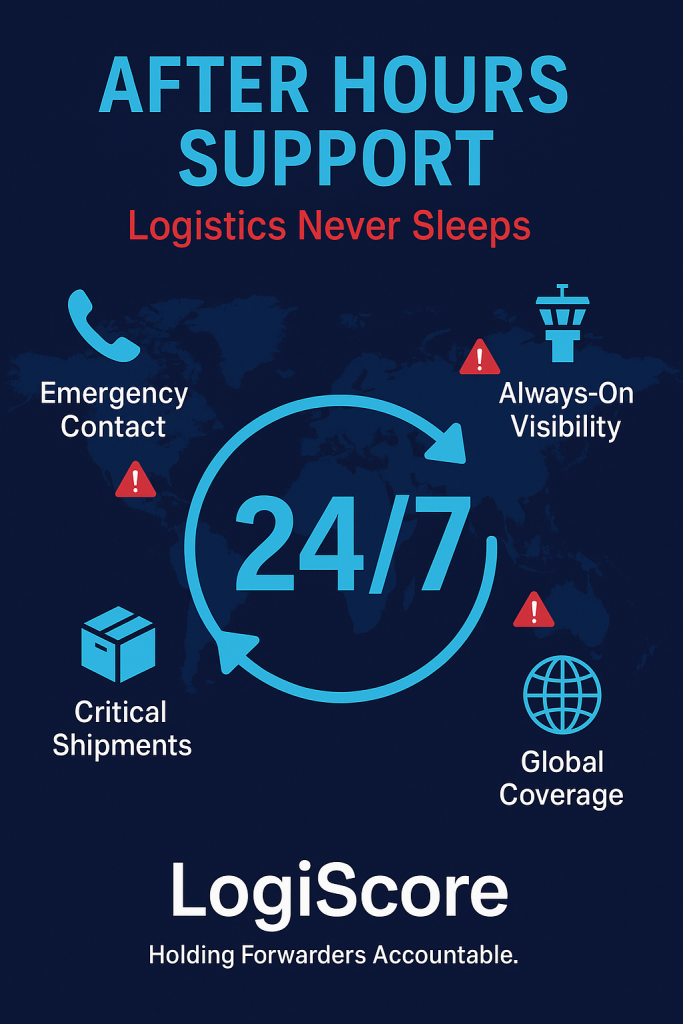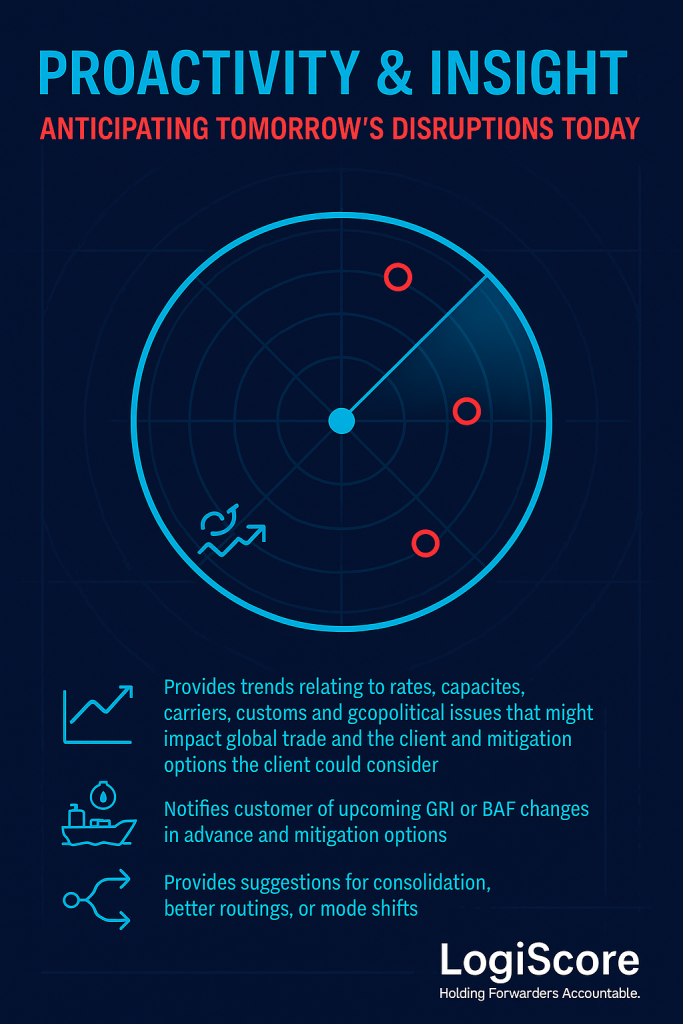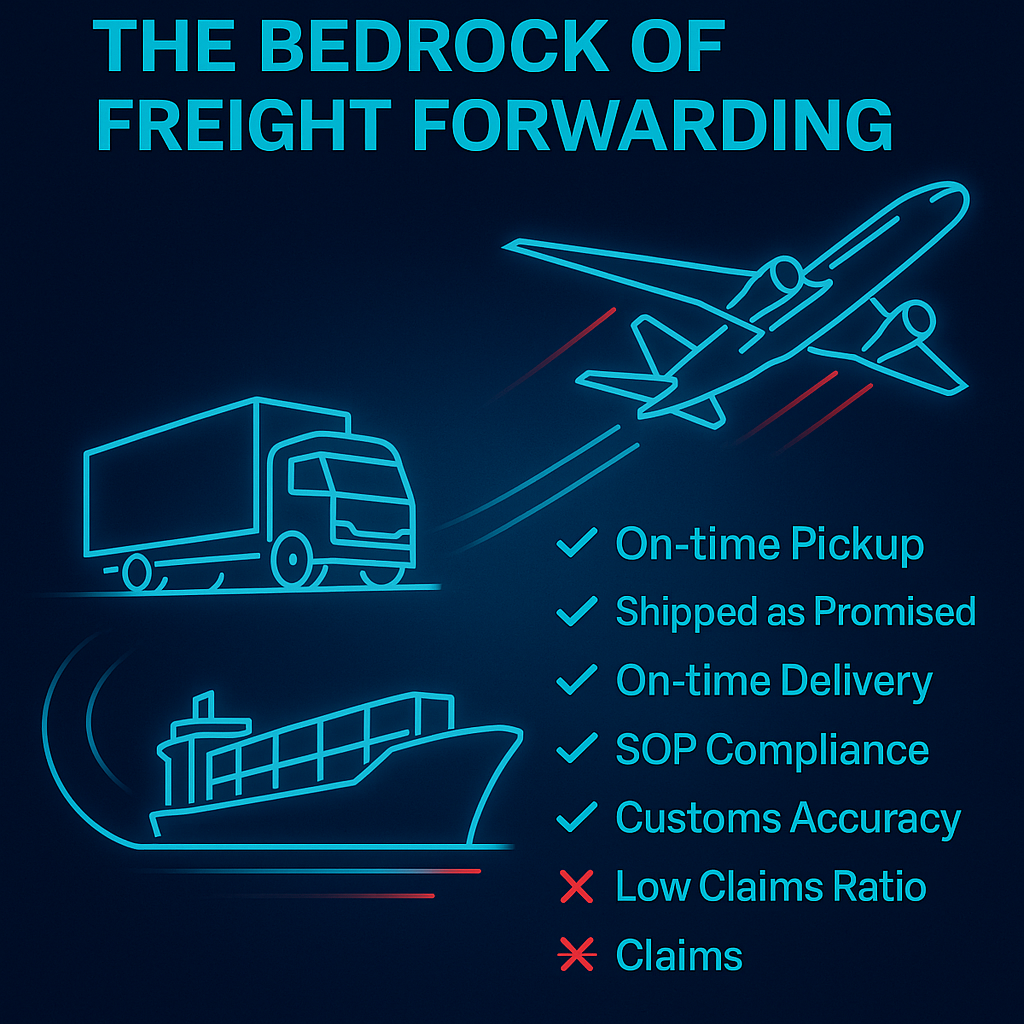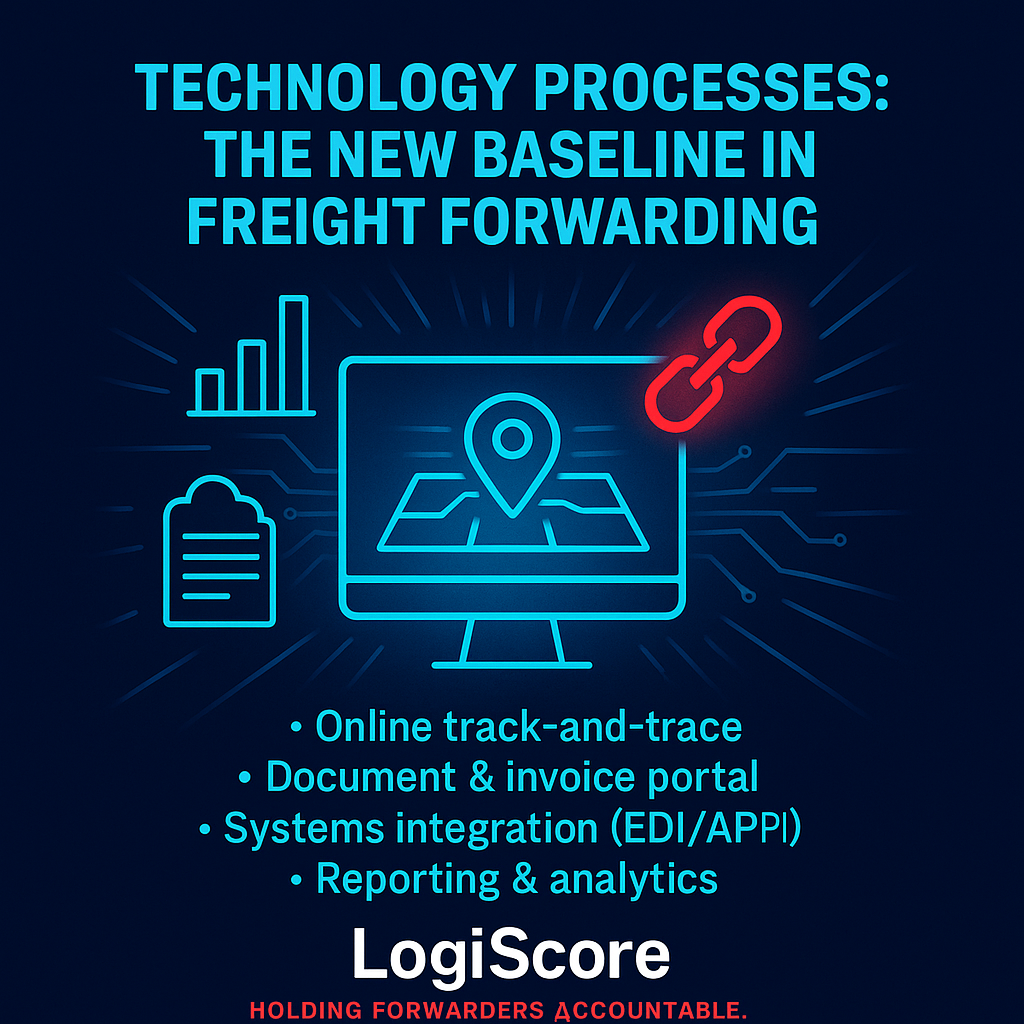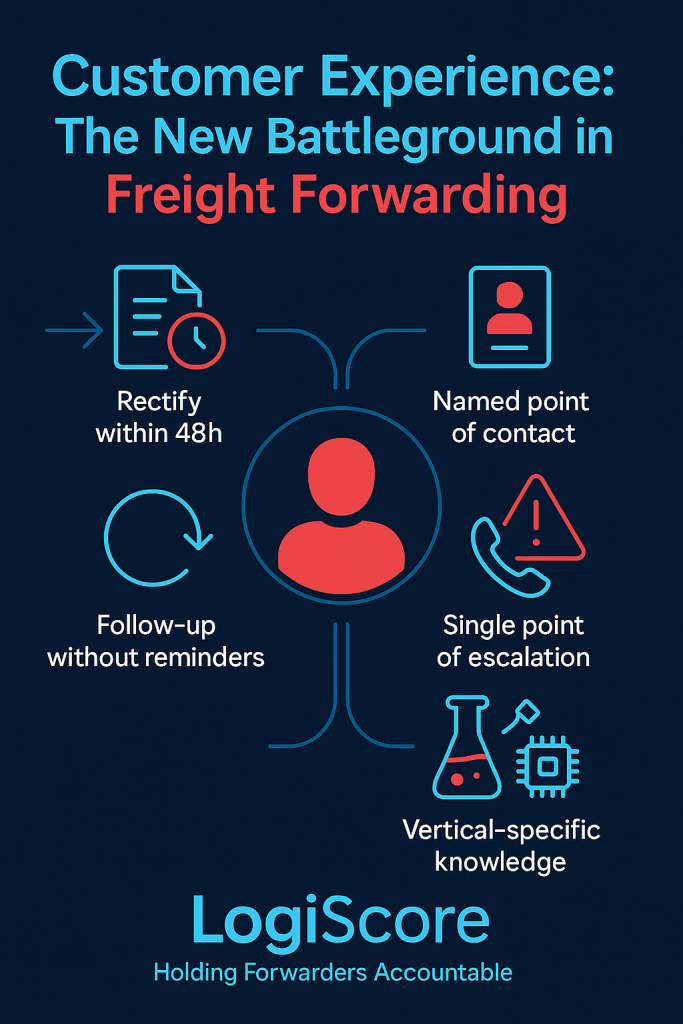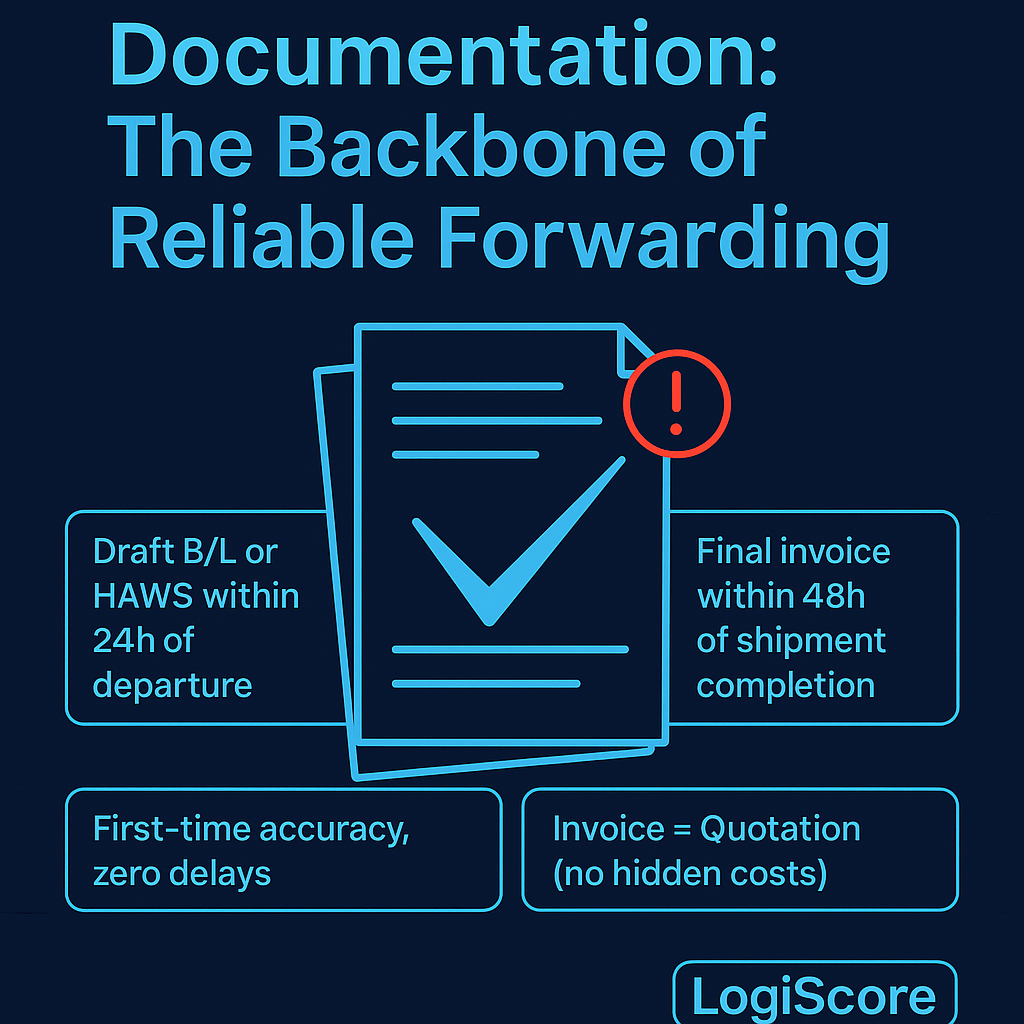In the fiercely competitive world of air and ocean freight forwarding, success is not just about bold strategies or expansive networks – it’s about how well you run the ship on a day-to-day basis. Research shows that companies often undervalue the power of competent management and superior execution. In fact, a landmark Harvard Business Review study concluded:
“Neither great leadership nor brilliant strategy matters without operational excellence.”
This thought leadership piece explores why operational excellence – the alignment, discipline, and continuous improvement in how a business is run – is the long-term game-changer for freight forwarders. We’ll start with an analytical look at management practices and then shift to a visionary perspective on achieving excellence in freight forwarding, covering alignment across departments, digital systems, process discipline, people capabilities, and pragmatic tech innovations like AI. The goal is to inspire leaders in freight forwarding to see operational excellence not as business-as-usual, but as a strategic differentiator that drives cost efficiency, service quality, and sustainable growth.
The Undervalued Core of Competent Management
Too often, C-suite leaders pour their energy into high-level strategy while treating day-to-day management as a back-burner issue. However, extensive research by Raffaella Sadun, Nicholas Bloom, and John Van Reenen (Harvard Business School) reveals that core management practices – such as target setting, performance monitoring, talent management, and rigorous operations – have a dramatic impact on performance. Companies vary widely in how well they execute these “basic” tasks, and those differences matter: firms with strong managerial processes “perform significantly better on high-level metrics such as productivity, profitability, growth, and longevity.” Even in strategy-driven industries, superior execution separates the high performers from the rest. Importantly, these advantages are persistent and hard to copy – a rival can’t simply clone your culture of operational excellence overnight.
In other words, brilliant strategy alone is not enough. As the HBR study argues, operational excellence should be treated as a crucial complement to strategy. If a company “can’t get the operational basics right, it doesn’t matter how brilliant its strategy is.” Conversely, “if firms have sound fundamental management practices, they can build on them” to develop more sophisticated capabilities (like analytics or cross-functional agility) that are essential in volatile markets. The takeaway for freight forwarding executives is clear: excellence in execution is not “table stakes” – it’s a differentiator. Competent management in target-setting, process discipline, and talent development creates a foundation that competitors struggle to imitate.
LinkedIn Pull Quote: Great strategy is useless without great execution – in freight forwarding, it’s the forwarders who excel at the “nuts and bolts” of operations that consistently outperform on profit, growth, and service.
Execution as a Differentiator in Freight Forwarding
Air and ocean freight forwarding has historically been a relationship-driven, margin-squeezed business. In such an environment, one might assume that “strategy” (e.g. securing capacity deals or opening new trade lanes) is the main success factor. But the reality on the ground shows that execution – cost-effective, reliable, and efficient operations – is what separates industry leaders from laggards over the long run. High-performing forwarders distinguish themselves through superior coordination, processes, and use of technology, not just through negotiating savvy or market positioning.
Consider the current state of the industry: Many traditional forwarders are burdened by siloed departments, manual workflows, and legacy systems. They face rising customer expectations for transparency and speed, yet often struggle with fragmented data and reactive problem-solving. Meanwhile, a wave of digitally driven startups and progressive incumbents is proving that better execution can rewrite the rules. According to Boston Consulting Group, a “digital imperative” is hitting freight forwarding – startups and even customers are leveraging technology to eliminate operational inefficiencies and vastly improve the experience (bcg.com). Traditional forwarders that fail to modernize internal processes risk being left behind. By BCG’s estimates, simply “automating manual processes now could reduce certain back-office and operations costs by up to 40%,” and digitizing parts of the sales and quoting process can cut those costs even further (bcg.com). In an industry obsessively focused on expenses, such efficiency gains are game-changing.
It’s telling that digital-native freight forwarders (the ones built on modern tech stacks) still only represent about 8% of the market, yet they are growing at over 23% annually (versus ~4% for traditional forwarders) (unicargo.com). They are pulling ahead by offering better visibility, faster service, and leaner operations – all fruits of operational excellence enabled by tech. To illustrate, digital forwarders automate tasks like quote generation, documentation and shipment tracking, which free up human staff for more strategic work and exception handling. The lesson for legacy forwarders isn’t to chase every shiny new technology, but to recognize that superior execution is itself a strategy. Firms that invest in integrating their teams, upgrading systems, and refining processes will not only cut costs but also deliver more consistently for customers. And consistency builds reputation and market share.
LinkedIn Pull Quote: Automating the “busy work” in freight forwarding can slash operating costs by up to 40% – the forwarders who seize these efficiencies are redefining industry standards on service and price. bcg.com
Breaking Down Silos: Aligning Sales, Procurement, and Operations
One of the most practical steps toward operational excellence is aligning all departments toward shared goals. In many forwarding companies, different teams – sales (commercial), procurement (carrier management), and operations (execution) – operate in their own silos. This misalignment breeds inefficiency and internal friction. For example, sales reps might promise a customer an ambitious delivery time or rate without real visibility into operational constraints, while procurement managers negotiate carrier contracts without input from frontline operations or sales forecasts. The result is all too common: “Sales reps might promise a delivery date they can’t meet, or operations might order more inventory than needed… These inefficiencies chip away at profitability.” Siloed data and communication make it harder to respond to issues, often leading to blame games instead of solutions. salesnow.com
Achieving cross-department alignment involves both cultural and systemic changes. Culturally, leaders need to foster a mindset that sales, procurement, and ops are all part of one value stream, ultimately serving the customer together. Practically, this means establishing regular interdepartmental meetings, shared KPIs (e.g. customer satisfaction, gross margin per shipment), and collaborative planning. For instance, forwarders can implement Sales & Operations Planning (S&OP) adapted to freight: sales forecasts inform procurement’s capacity planning; procurement’s carrier commitments inform sales on what services/rates to sell; operations provide feedback on service issues to both. Adopting integrated software can also break down silos – a CRM or TMS that gives all teams real-time access to the same data (quotations, bookings, shipment status, costs) ensures everyone is working off a “single source of truth” rather than disconnected spreadsheets.
Critically, alignment requires shared objectives. As one industry expert noted, procurement and commercial teams often have differing mandates (cost-cutting vs. revenue growth), which leads to friction – “but when both functions recognize that cost efficiency and revenue growth are two sides of the same coin, they can align around shared goals like profitability, customer value, and long-term sustainability. True business impact happens not when one side wins, but when both functions move in lockstep.” In freight forwarding terms, that could mean structuring incentive plans so that salespeople are rewarded not just for top-line volume but for profitable growth and customer retention, while procurement is measured not just on securing low rates but on enabling service reliability and capacity for sales. Joint accountability creates unity. enable.com
When sales, procurement, and operations collaborate closely, a forwarder can, for example, respond to a large customer RFP with a solution that balances competitive pricing (thanks to procurement’s input on carrier costs), achievable service levels (thanks to ops input on realistic transit times), and a clear value story (thanks to sales). Internally, this alignment reduces costly miscommunications and ensures resources are used optimally. The payoff is stronger project outcomes, deeper customer trust, and long-term success – all hallmarks of operational excellence.
Building a Digital Backbone: Systems and Process Discipline
Alignment must be supported by a solid digital backbone – the core systems and processes that run the forwarding business. In 2025, it’s alarming that “only 23% of freight forwarders have digitized more than 75% of their processes, and less than 40% are using a dedicated freight forwarding management system.” Many forwarders still rely on email, spreadsheets, and paper for critical workflows (quoting, booking, documentation, tracking, billing). This lack of digitization not only drives up labor costs and error rates, but also makes it nearly impossible to scale or gain real-time visibility. Operational excellence demands moving away from ad-hoc manual methods to integrated, efficient systems. info.magaya.com
The core digital tools for a modern freight forwarder include: an Enterprise Resource Planning (ERP) system for finance and administration, a Transportation Management System (TMS) or freight forwarding software for planning and tracking shipments, and specialized platforms for areas like procurement (e.g. spot rate platforms, carrier management systems) and customer service (online track-and-trace portals, electronic documentation). By adopting these systems – and crucially, integrating them – forwarders can eliminate redundant data entry, reduce mistakes, and gain end-to-end visibility of operations. For example, a TMS can automatically consolidate shipments and suggest optimal routing, while an integrated procurement tool can automatically compare carrier rates and capacities, flagging the best options for each lane. TMS software automates functions like carrier selection, routing and rating, helping users cut shipping and labor costs through smarter decisions. descartes.com.
However, simply buying software is not a silver bullet. True operational excellence comes from process discipline and documentation layered on top of these systems. A best-in-class forwarder will invest time in mapping out and standardizing processes: from how a sales lead is handed off to pricing, to how bookings are made and monitored, to how exceptions (like delays or cost overruns) are escalated and resolved. These processes should be clearly documented, taught, and continuously improved. In fact, “process documentation” and regular KPI reviews were identified in the HBR research as key aspects of strong performance monitoring. When everyone follows well-defined standard operating procedures, there is less room for error or individual workarounds. New employees can be onboarded faster, and management can more easily pinpoint where issues occur.
With digital systems in place, data becomes an asset for improvement. Forwarders can track performance metrics such as transit times, quote-to-booking conversion rate, on-time delivery, cost per shipment, and productivity per employee. Monitoring these in dashboards (and reviewing them in team meetings) turns management into a fact-based discipline. Teams can set targets (another core practice from the HBR study) and course-correct when metrics slip. For instance, if on-time delivery is dipping, a root cause might be uncovered (perhaps a particular carrier or trade lane underperforming) and addressed proactively. If sales quote conversion is low, maybe pricing processes need adjustment or sales training. Performance monitoring closes the loop of operational excellence – you can’t improve what you don’t measure.
LinkedIn Pull Quote: Less than 40% of forwarders have a modern TMS in place info.magaya.com. Yet those who do enjoy real-time visibility, fewer errors, and scalable processes – the backbone of efficiency in an industry where every minute and dollar counts.
People and Proficiency: Training for Excellence
Even the best systems and processes won’t deliver results without the right people skills and organizational culture. Operational excellence in freight forwarding is ultimately driven by teams of humans – from the sales reps and pricing analysts to the operations coordinators and branch managers. That’s why talent management is a core pillar of competent management. Forwarders must ensure their people are not only capable and well-trained, but also empowered and motivated to follow best practices and seek improvements.
A critical area is proficiency in using operational systems. It’s common to see freight forwarding companies invest in a new TMS or CRM, but a year later many staff are still clinging to old habits (e.g. manually building quotes in Excel because they find the new system cumbersome, or keeping their own customer notes outside the CRM). To avoid this, leadership has to champion robust training programs and change management. Every employee should understand why the new process or system is beneficial and receive hands-on training to become comfortable with it. Additionally, companies can designate “power users” or champions in each department who can support colleagues and continuously identify ways to leverage more system features. Remember, technology adoption is as much about people as tech – as one report noted, successful digital transformation requires rethinking processes and culture (info.magaya.com). Investing in reskilling your workforce is part and parcel of investing in operational excellence. As a recent freight procurement study advised, “Focus on change management and reskilling initiatives to ensure your team embraces the new tools effectively.”(freightender.com)
Talent management in an operational context also means hiring and developing the right mindset. Freight forwarding has traditionally been managed by industry veterans whose expertise is invaluable, but the future demands blending that domain knowledge with analytical and continuous improvement skills. Leaders should encourage a culture of ongoing improvement: for example, empower front-line staff to suggest process tweaks, reward teams for finding cost-saving or service-improving ideas, and cross-train employees so they understand the end-to-end flow (improving cross-functional empathy). Setting stretch goals can motivate teams – HBR’s research found that companies with a “talent mindset” at top levels, which set challenging goals and actively managed performance and development, tended to excel. In practice, a forwarder’s leadership might set a goal like “improve documentation processing productivity by 20% this year” and then involve teams in finding solutions (perhaps through better software use or eliminating duplicative steps).
Crucially, leadership must set clear goals and provide a roadmap. Employees take operational excellence seriously when they see that top management genuinely cares about it. This means the CEO and other leaders should articulate a clear vision (e.g. “We will become the most efficient and reliable forwarder in our market”), translate that into specific objectives (cost targets, service level targets, technology rollouts), and communicate a roadmap of how to get there. They must also lead by example – for instance, by rigorously reviewing performance dashboards, asking managers tough questions about operational metrics, and celebrating wins when process improvements yield results. When leadership treats operational excellence as a strategic priority (not just a project du jour), it signals to everyone that “management quality” is as important as sales figures or strategic deals. Indeed, organizations need competent management just as much as they need analytical brilliance. A forwarder where the CEO talks as passionately about on-time performance and system adoption as about new customer acquisition is a forwarder on the way to excellence.
Embracing Practical Innovation: AI and Data Analytics in Forwarding
No discussion of operational excellence today would be complete without addressing emerging technologies like Artificial Intelligence. But let’s be clear: freight forwarders as a whole have been laggards in IT maturity, so the aim here is not to paint a sci-fi picture of autonomous logistics running on AI (a scenario that many in this sector would find far-fetched). Instead, the focus is on realistic, actionable applications of AI and analytics that augment human decision-making and drive practical improvements in cost and service. These technologies, when layered on the solid foundation of people, process, and systems discussed above, can be powerful catalysts for efficiency.
Here are a few examples of how forwarders can leverage AI today in a sensible way:
- Predictive ETA Adjustments: Rather than relying solely on static transit times provided by carriers, forwarders can use machine learning models that analyze real-time data (vessel locations, port congestion, weather, historical trends) to continuously update shipment ETAs. These AI-driven predicted ETAs are far more accurate and dynamic. In fact, specialized platforms have shown they can predict ocean freight arrival times 30% more accurately (even 2-4 weeks out) than the estimates carriers provide (portcast.io). By integrating such predictions into their operations, forwarders can proactively inform customers of delays, re-route shipments, or adjust downstream plans – improving reliability and customer satisfaction. In essence, AI can give forwarders and their clients a heads-up weeks before a problem hits, turning agility into a competitive advantage.
- Dynamic Pricing and Yield Management: Freight rates in both air and ocean markets can swing rapidly with supply and demand. Traditionally, forwarders set pricing using static margins over cost or periodic rate sheet updates, which can lead to lost opportunities (either leaving money on the table in tight markets or losing business in soft markets). AI-powered dynamic pricing changes that. Algorithms digest real-time market conditions – freight capacity, demand surges, fuel costs, even competitor rate data – and can suggest optimal price adjustments on the fly. This means during a capacity crunch, the system might nudge selling rates upward to maximize margin, whereas during a slow spell it might lower certain lane rates to win volume, all within parameters the company sets. As one logistics firm described, AI-driven pricing analyzes vast real-time information (demand, available capacity, operational costs) and adjusts freight rates instantly to reflect current market conditions, ensuring rates remain competitive yet profitable. (pgs-log.com. This adaptive approach not only protects margins but also improves win rates. Several forwarders and digital platforms already use instant quoting tools that leverage AI to give customers dynamic spot rates. The key is these systems can factor in more variables than a human ever could – from weather to warehouse space – to optimize pricing in a way that maintains service and profitability balance (pgs-log.com). Early adopters of such adaptive pricing have reported better capacity utilization and improved customer satisfaction due to more consistent, transparent pricing.
- AI-Assisted Procurement & Operations Planning: Perhaps the most impactful near-term use of AI for forwarders lies in automating and enhancing procurement decisions. This involves using AI agents to crunch through huge datasets of carrier rates, performance history, shipment patterns, and even external factors like economic indicators or fuel trends. The AI can automate routine procurement tasks – for example, automatically generating an RFQ to carriers based on upcoming capacity needs, or scanning incoming carrier bids to flag anomalies and suggest the best options. According to one analysis, AI-based procurement platforms can “examine carrier proposals for anomalies, perform lane-by-lane cost benchmarking, and even generate counter-bid recommendations based on current market intelligence.” (freightender.com) By continuously analyzing performance, such systems might also highlight, say, that Carrier X’s on-time rate has dropped this quarter or that a certain contract is coming up for renewal and market rates have fallen – prompting the procurement team to renegotiate proactively. The gains from AI in freight procurement are tangible: early adopters have seen about a 15% reduction in logistics costs and a 65% improvement in service levels through smarter, faster decision-making (freightender.com). Similarly in operations, AI can assist with load planning (consolidation and routing optimization algorithms) and exception management (e.g. predicting which shipments are at risk of delay or which customers might experience a service failure this week). Importantly, these tools augment your team’s capabilities – they take over grunt work and surface insights, so your human experts can focus on high-value tasks like carrier relationship management or custom solutions for clients.
It’s worth noting that implementing AI solutions should be done judiciously. Quality data is a prerequisite – forwarders must clean up and integrate their data (another benefit of the digital backbone) for AI models to be effective. Moreover, change management is critical; your staff should trust and understand the AI’s role. The best results come when AI is introduced as a co-pilot for employees, not a black box. A great approach is to start with pilot projects in one area (say, automated quote pricing or an AI lane cost analysis) and measure the impact, then iterate. This targeted experimentation prevents overwhelm and builds confidence in the tools. And always keep the customer in focus: any AI deployment should ultimately enhance the customer experience (through better on-time performance, faster quotes, fewer errors, etc.). If it doesn’t, reconsider the effort.
In summary, AI and analytics are rising in freight forwarding – not to replace the human touch that the industry prides itself on, but to amplify operational excellence. They enable forwarders to anticipate rather than react, to optimize rather than guess, and to deliver more value with the same resources. A freight forwarder that has aligned teams, digitized processes, and skilled people is ripe to reap the benefits of these emerging tools, whereas one that hasn’t laid the groundwork will find AI to be just hype. The message to leadership is to envision a future where your company is data-driven and AI-assisted, and take tangible steps toward it, one use-case at a time.
LinkedIn Pull Quote: Predictive analytics are turning data into gold for forwarders – for example, AI can improve ETA accuracy by 30% (portcast.io), enabling proactive re-routing and communication that saves money and keeps customers happy.
Conclusion: Excellence as a Long-Term Differentiator, Not a Quick Fix
Operational excellence in air and ocean freight forwarding is a journey, not a destination. It requires persistent focus, investment, and leadership commitment – but the rewards are profound. In an industry buffeted by price pressures, capacity swings, and external disruptions (from pandemics to trade wars), the forwarders that thrive are those with resilient, efficient, and agile operations. By aligning departments toward common goals, building a robust digital backbone of systems and processes, nurturing talent and a culture of continuous improvement, and leveraging practical tech innovations, freight forwarders can transform their operational capabilities. This is not about a one-time cost-cutting initiative or a flashy tech project. It’s about weaving a fabric of excellence through the organization that drives incremental improvements every day.
Leaders must champion this cause. They need to make the business case that operational excellence is a long-term differentiator – it’s what will set the company apart in service quality, in cost leadership, in adaptability to change. This is especially true when strategic differentiation is hard to achieve in forwarding (many forwarders offer similar global networks and services). Execution becomes the edge. As the HBR study reminded us, world-class management practices are “a powerful way to become more competitive” and could be the best route out of the doldrums in a low-growth environment. Moreover, because excelling at management and operations is difficult and requires sustained effort, it’s an advantage that competitors can’t easily steal. In practical terms, a forwarder known for its reliability, efficiency, and proactive service will win customers and weather downturns better than one known for inconsistent execution – even if they have similar rates or coverage.
For too long, competent management in freight forwarding has been undervalued – often overshadowed by the chase for the next big customer or the next strategic expansion. It’s time to correct that undervaluation. Superior execution should be part of the brand you present to the market. It should be part of the story you tell customers (“We consistently deliver because our operations are second to none”). And it should be a source of pride internally, where employees at all levels understand their role in a high-performing machine and are recognized for contributions to efficiency and service.
In conclusion, operational excellence is not a cost center – it’s a value creator and a strategic asset. Freight forwarders that embrace this mindset can turn what is often seen as “ordinary work” into extraordinary results. They’ll enjoy lower costs, happier customers, engaged employees, and a future-ready business. As you lead your organization, remember the simple truth that opened this article: great strategy alone won’t carry the day if execution falters. But when you marry a sound strategy with world-class execution, there’s little that can’t be achieved. In the complex, ever-changing arena of global logistics, that marriage – of vision and operational excellence – is what will propel the winners of tomorrow.
LinkedIn Pull Quote: Operational excellence isn’t a one-time project or a fancy slogan – it’s a culture. It’s the hard work of running a freight forwarding business right every single day. Do that, and no market storm can sink you.
Sources:
Freightender (2024). “Why AI Freight Procurement Is Making Supply Chains Smarter.” – Discusses AI in freight procurement, noting 60%+ of tasks still manual, and that early AI adopters saw ~15% cost reduction and 65% service level improvementfreightender.comfreightender.com. Also stresses change management for successful AI tool adoptionfreightender.com.
Sadun, R., Bloom, N., & Van Reenen, J. (2017). “Why Do We Undervalue Competent Management?”Harvard Business Review – Research findings on how core management practices (target setting, performance monitoring, operations, talent management) drive performance.
Boston Consulting Group (2018). “The Digital Imperative in Freight Forwarding.” – On the impact of digitization in freight forwarding and potential cost reductions from process automationbcg.combcg.com.
Unicargo (2023). “Digital Freight Forwarding Trends for 2024: What to Expect.” – Industry stats on digital forwarders’ market share (8%) and growth (23% annually) vs traditional, and benefits of digital platforms in efficiencyunicargo.comunicargo.com.
SalesNOW Blog (2023). “Breaking Down Silos: How CRM Integration Connects Sales and Operations.” – Example of misalignment between sales and operations leading to poor decisions and inefficienciessalesnow.com.
Enable.com Blog (2025). “The Power of Commercial-Procurement Alignment.” – Insight into aligning procurement and sales goals; shared vision of profitability and moving in lockstep for true business impactenable.com.
Magaya/Adelante SCM Report (2025). “State of Digitization in Freight Forwarding 2025.” – Survey findings that only 23% of forwarders have heavily digitized their processes and <40% use a forwarding management systeminfo.magaya.com.
HBR – Sadun et al. (2017). Core managerial practices sidebar. – Emphasizes process documentation, KPI usage, target clarity, and talent development as fundamentals of operational excellence.
PGS Logistics (2025). “Adaptive Pricing in Freight Forwarding: Using AI for Real-Time Rate Adjustments.”– Describes how AI enables dynamic pricing based on real-time data (demand, capacity, etc.) to optimize rates and profitabilitypgs-log.compgs-log.com.
Portcast (n.d.). “Predictive ETA and Transportation Visibility for Ocean Freight.” – Reports that AI-driven predicted ETAs can be ~30% more accurate than carrier-provided ETAs 2-4 weeks in advanceportcast.io.



